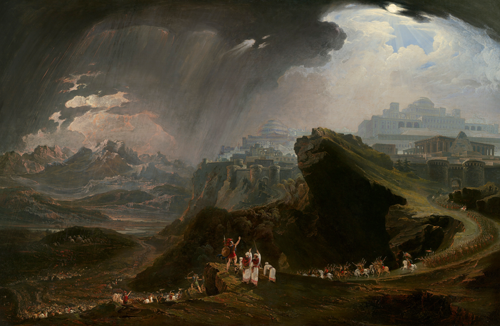
In the article quoted in the epigraph, English writer Paul Kingsnorth puts his finger on the perplexing challenge of climate change. Like a persistent teacher, he writes, climate change pushes us to acknowledge the reality of limits in both ourselves and in the environment. It demands that we learn to live within the planet’s envelope of ecological generosity. If we can do so, he argues, we can not only survive but thrive and prosper. But if we ignore or try to violate this envelope or attempt to control nature, believing we are immune from its limits, our prospects for surviving the threat of climate change are perilously compromised.
“Climate change is really a lesson in limits: the limits of the atmosphere’s ability to absorb our waste, the limited ability of our economics and politics to deal with what’s coming, the limits of our control over nature and ourselves.” —Paul Kingsnorth, “The Four Degrees,” London Review of Books, October 2014
Avoiding the worst of climate change demands answers to key scientific questions. What are the limits of the planet? Has science ascertained what those limits are and how much farther we have to go before we hit them? Does the planet have a “carbon budget,” a limited amount of carbon to be burned before we pass a threshold of no return? And how do our current fossil fuel energy structure and economy assist or hinder us as we try to find a way to manage the threat?
Those are the questions for science. But there is another element to the search for a way forward, rooted in the ethical imperatives that will enable us to chart a sustainable course: Do ancient philosophies and faith traditions have wisdom embodied in their teaching that might assist us?
In this time of increasing concern regarding the threat of climate change, we are in desperate need of a heuristic or a conceptual tool that will reconfigure our thinking and enable the development of effective public policy on addressing climate change, protecting the environment on which we rely for survival and safeguarding our economy. So the defining question moving forward becomes what public policy on climate change, energy and protecting the planet’s commons would look like if we accepted the science—and the morality—of limits on the planet’s resources.
In what Karl Jaspers (and later Karen Armstrong in her book The Great Transformation) called the Axial Age (800 BCE to 300 BCE), several philosophies and religions emerged that would transform human civilization. These traditions included philosophies such as Confucianism in eastern Asia and the Greek philosophies in the Ancient Near East, as well as faith traditions such as Taoism, Hinduism and Buddhism in central Asia and Judaism in the Ancient Near East.
Born in a time of great civil strife and violence, these philosophical traditions highlighted the visionary and revolutionary ideal of a common good and extolled compassion as a core ethical behaviour. Rather than elevate the primacy of the individual, these value systems highlighted the common good as a collective goal and social principle. Instead of endorsing the rampant hyperconsumption that characterizes contemporary society, these philosophies and faith traditions located society and its economy in a larger context that placed limits on the wealthy and advocated justice for the vulnerable and the marginalized: widows, orphans, foreigners.
These philosophical traditions highlighted the visionary ideal of a common good and extolled compassion as a core ethical behaviour.
These traditions also saw a direct connection between the stability of society and respecting the limits of the land. They called for protecting the ecological communities of plants and animals as well as the cycles of water, climate and soil replenishment. Nature was perceived as being saturated by a moral order that was embedded in its very existence. While contemporary society sees the value of nature as extrinsic—nothing more than dead matter until given value by a human being—these traditions saw that nature’s worth was intrinsic, a sign of a larger mystery in the universe.
Rather than treating nature as an inert resource that could be extracted, consumed and disposed of by human beings, these traditions offered a framework for respecting and protecting it as belonging to the cosmic mystery. This expectation of caring for and protecting the created order was based on ordering human society and economy within the larger cosmic economy. These principles and values were expressed in a sense of justice-centred social interaction and economic transaction, imposing the same ordering principles on the micro (the individual) that were perceived in the more macro cosmic order.
These insights are refracted in various ways through the lenses of diverse wisdom traditions. For instance, the philosophy of Confucianism perceived that human society was a microcosm and replica of the larger cosmic macrocosm embedded in the universe’s patterning. The microcosm of human society of necessity needed to be ordered so that was a harmonious duplication of the macro-cosmic order. The religious tradition of Judaism understood the cosmic covenant (berit) to include three partners: God, humanity and nature, each of which had its own rights and responsibilities within the covenantal web of relationships. In Judaism, the patterning in the universe was a moral order with limits and boundaries.
In these wisdom traditions, the violation of these limits results in repercussions for humanity: a destabilization of nature and the climate, the diminishing of the “goods and services” that nature provides, which in turn leads to a destabilization of society, food production and the economy and, ultimately, to environmental and social collapse.

If wisdom traditions have provided some insight into the order of nature and its inherent limits, science has determined these limits through the lens of scientific inquiry. In 2008, James Hansen, the former head of NASA’s Goddard Space Center, led a team to research how the “safe zone” of the planet’s climate might be expressed scientifically. What, they asked, is the stable level of ppm (parts per million) of carbon dioxide that will stabilize not only the climate systems but all of the organic living systems, including the ecological niche for continued human habitation?
In the article “Target Atmospheric CO2: Where Should Humanity Aim?” Hansen’s team concluded that the safe level of carbon dioxide for a stable climate is 350 ppm. This level of CO2 is substantially below the current level of carbon dioxide of 400 ppm. When it comes to climate and atmosphere, our environmental “home” is 350 ppm, a critical marker if we wish to continue to thrive or survive on the planet.
But what are the actual carbon limits of the planet? How close is humanity to hitting this limit, and just how much of the planet’s carbon budget have we used?
In 2009, scientists from Germany, the United Kingdom and Switzerland led by Malte Meinshausen, a professor at the Potsdam Institute for Climate Impact Research, set out to answer these questions in an article entitled “Greenhouse-Gas Emission Targets for Limiting Global Warming to 20 C.” Through their research, they ascertained that if the world burned 886 gigatonnes (Gt) of carbon between 2000 and 2050, there was an 80 percent chance of keeping the rise in global temperatures below that threshold.
But by 2011, the world had already used over one-third of that 50-year carbon limit, leaving a carbon budget of 565 Gt of carbon. Other researchers have concluded that if we stay on our present trajectory, we would hit the limits of the planet’s carbon budget by about 2028. A child born in 2014 would be just entering high school when we would be exhausting the earth’s carbon budget.
Meanwhile, the Carbon Tracker Initiative, an organization of financial analysts in the UK, released a groundbreaking report in 2012 that put the planet’s existing reserves of oil, gas and coal at about five times greater (2,795 Gt CO2 than the remaining carbon budget of the planet (565 Gt CO2). Carbon Tracker and other financial analysts have concluded that only 20 percent of the total corporate reserves can be consumed, leaving the rest essentially unburnable, making them “stranded assets.”
The implications of a Canadian economy tethered to the oil sands and carbon-intensive industries are stark: a significant share of oil, gas and coal reserves—including Canada’s oil sands—would need to stay in the ground to keep us within the planet’s carbon budget, which would have a serious impact on economies in Alberta and across Canada.
For policy-makers, the implications are daunting. Without adhering to limits, we risk the perils of a warming planet. But to do so requires altering behaviour and economic systems that have arisen as part of a culture based on easily accessible fossil fuels. Somehow, we must find a way to place the concept of a carbon budget at the heart of our energy policy.
And if our current politics are failing us and the road seems dark, a spark can be found by looking within our ancient wisdom traditions. They have already grappled with the questions of how to order societies in a world of limits. It is to them we can turn for the existential insights and ethical imperatives to guide us, to learn how to live and thrive within the envelope of limits, and within the planet’s generosity.
Photo: Shutterstock







